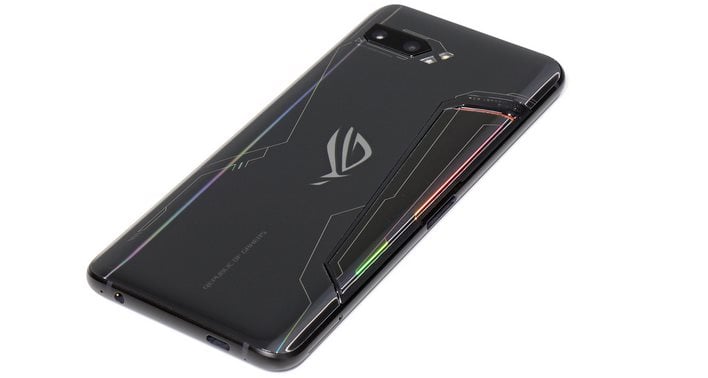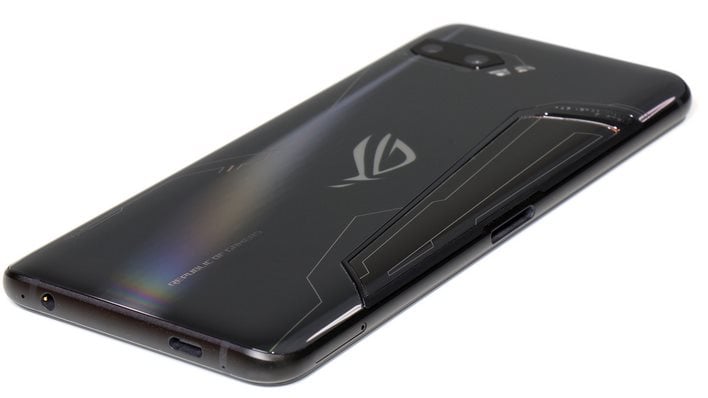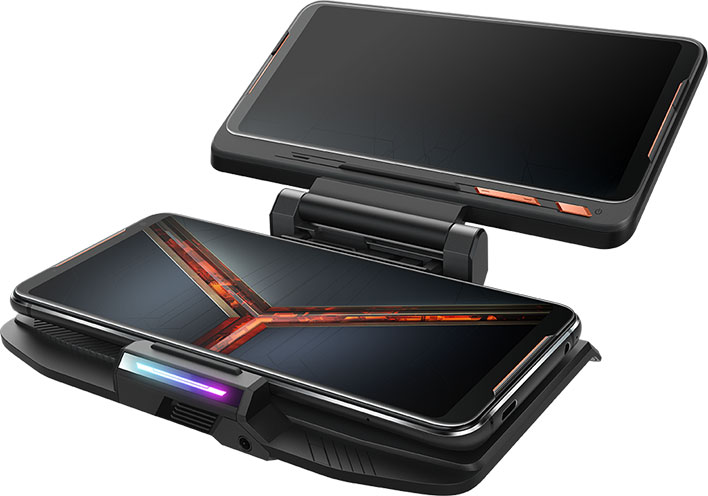ASUS ROG Phone II Review: A Mobile Gaming And Battery Life Beast
ASUS ROG Phone II: An Elite Gaming Phone
The concept of a purpose-built gaming phone is still somewhat in its infancy, though we are starting to see generational upgrades, such as the ASUS ROG Phone II. As the name implies, this is the second generation of ASUS' gaming handset. Like the original ROG Phone released last year, the ROG Phone II combines bleeding edge hardware with gaming-centric software optimizations. ASUS sprinkles in some nifty features (like Air Triggers) and then surrounds it all with optional accessories to amp up the experience. What ASUS has essentially created is not just a gaming phone, but a smartphone gaming ecosystem.
For this second act, ASUS sets the stage with some notable upgrades. One that perhaps stands out the most is the display—the 6.59-inch AMOLED screen (2340x1080 | 19.5:9) bumps up the maximum refresh rate to 120Hz, versus 90Hz on the original ROG Phone. Not only does this bring refresh rate parity to the first and second generation Razer Phone, both of which tout a 120Hz LCD screen, ASUS earns itself bragging rights because it is hitting 120Hz on a superior AMOLED panel.
No other smartphone exists with both an OLED screen and 120Hz refresh rate at this time. In addition, ASUS touts a 1ms response time and a 240Hz touch response, which is a measurement of the number of times per second the screen reports a touch point's position. Rounding out the display's specs, this is a 10-bit panel with HDR support, 600 nits brightness, 500,000:1 contrast ratio, and a wide color gamut (108.6 percent coverage of the DCI-P3 color space).
There is not much to criticize about the actual display, at least the visual portion. Surrounding it, however, is a traditional bezel design. The thickest portions are on the top and bottom. Due to this, the ROG Phone II is noticeably bigger than other phones with similar sized displays. It measures 6.73 x 3.05 x 0.37 inches (170.99 x 77.6 x 9.48 mm) and weighs a hefty 8.47 ounces (240 grams). To put that into perspective, the OnePlus 7T with its 6.55-inch display measures 6.69 x 2.93 x 0.32 inches (69.94 x 74.44 x 8.13 mm) and weighs 6.7 ounces (190 grams)
Even Samsung's Galaxy Note 10 Plus is a physically smaller and lighter phone, despite having a bigger 6.8-inch display—that phablet measures 6.39 x 3.04 x 0.31 inches (162.3 x 77.2 x 7.9 mm) and weighs 6.91 ounces (196 grams). Nevertheless, the ROG Phone II is not unwieldy for a larger sized handset, provided you prefer a bigger phone.
|
| SoC | Qualcomm Snapdragon 855+ |
| Display | 6.59" AMOLED (2400x1080 | 19.5:9), 120Hz/1ms, 600 nits, HDR |
| Memory | 12GB LPDDR4X |
| Storage | 512GB UFS 3.0 |
| Rear-Facing Cameras | 48MP f/1.79 (main) Sony IMX568, 13MP f/2.4 (125-degree ultra wide angle) |
| Front-Facing Cameras | 24MP f/2.0 |
| Video Recording | 4K at 60 fps, 1080p at 60 fps (240 fps slow motion), 720p at 30 fps (480 fps slow motion) |
| Battery | 6,800 mAh |
| OS | Android 9 / ROG Gaming UI 2.0 or Zen UI Classic (dealer's choice) |
| Dimensions | 170.99 x 77.6 x 9.48 mm |
| Weight | 240 grams |
| Connectivity | 802.11ad Wi-Fi, Bluetooth 5.0, NFC, USB-C, LTE |
| Colors | Glossy Black |
| Pricing | $899.99 -- Find It At Amazon |
ASUS ROG Phone II Hardware And Power Specs
The ROG Phone II gets a bump in specs that extend beyond the display. Sitting inside is Qualcomm's flagship Snapdragon 855+ SoC, which is a specially-binned Snapdragon 855 chip that has been qualified to run at 2.96GHz (up from 2.84GHz). Incidentally, the original ROG Phone also ran at 2.96GHz, by way of a specially binned and overclocked Snapdragon 845 SoC.
For gaming and graphics, the Snapdragon 855+ wields an Adreno 640 GPU that can boost its performance by roughly 15 percent above spec. To be clear, ASUS is not actually overclocking the CPU and GPU cores in the ROG Phone II as it did with the original ROG Phone. ASUS does not have to this time around, because Qualcomm already did that—the Snapdragon 855+ is the same chip as the non-plus variant, but clocked higher. There is still a performance oriented X Mode, however, which we will cover in a bit.
In addition to getting a newer SoC, ASUS increased the amount of RAM to 12GB (up from 8GB) and upgraded the storage to 512GB of UFS 3.0 for the Elite Edition reviewed here, and 1TB for the Ultimate Edition that will be available in December. There's no microSD slot, so the bump to 512GB for the baseline configuration is certainly welcome.
ASUS ROG Phone II Design
The design language on the ROG Phone is straight out of the Republic of Gamers playbook. Aggressive lines and angled accents abound, such as the slanted ventilation slash on the rear. An ROG logo sits in the center and lights up, and in case that's not recognizable enough, the words "Republic of Gamers" are stamped on the back as well.
There's a "mirror gloss" sheen on the Elite Edition model reviewed, while the Ultimate Edition distinguishes itself visually with a matte black design. Calling it mirror gloss is a bit of an oversell. It does not have the same reflective qualities like we have seen on some other phones, such as the Galaxy Note 10 or even models like Huawei's Honor 8. However, light rays do bounce off as you angle the phone, and overall it is an attractive handset with a gamer aesthetic.
Two physical buttons adorn the right side, including a volume rocker and power button, and on the bottom there's a 3.5mm audio jack (hooray!) and a USB-C port. Over on the left is where the most interesting bit resides. This is where you will find the side-mounted port consisting of a USB-C port and a proprietary connector for hooking up external accessories. The included clip-on AeroActive Cooler II utilizes the side-mounted port assembly while offering USB-C passthrough.
Returning to the topic of bezels, one of the reasons they are there is to make room for the dual front-facing stereo speakers with DTS:X Ultra. The audio quality on the ROG Phone II is among the best we have heard from a phone. It's not going to compete with a set of high end earphones or external speakers, but compared to most phones (including Samsung's lineup), the audio is a real differentiator. It also gets loud, courtesy of a smart amplifier, without degrading into a distorted mess.
ASUS ROG Phone II Camera Arrangement
Smartphones are becoming increasingly adept at taking photos, both in terms of the hardware and the software processing that takes place. As part of this evolution, smartphones are wielding more camera sensors these days—a spattering of handsets feature four rear cameras.
Be that as it may, ASUS stayed rather conservative with the camera configuration on the ROG Phone II. The front of the phone gets just a single sensor, albeit a 24-megapixel shooter. On the rear, users will find two sensors, a 48-megapixel main shooter (Sony IMX568) with an f/1.79 aperture, and a 13-megapixel ultra-wide angle (125 degrees) sensor with an f/2.4 aperture. There's no telephoto lens or depth sensing camera.
This is a bit disappointing for what is otherwise a no-holds-barred flagship phone. ASUS is gambling that users who are in the market for a gaming phone will not be as interested in a decadent camera arrangement, and we think the company has miscalculated here.
ASUS ROG Phone II Accessories - A Smorgasbord Of Add-Ons
One thing that is not lacking on the ROG Phone II is the wide assortment of accessories. There are half dozen in all, at various price points., They include...
- Desktop Dock: $229.99
- TwinView Dock II: $329.99
- ROG Kunai Gamepad: $149.99
- ROG Phone II Lighting Bumper: $59.99
- Pro Dock: $119.99
- WiGig Display Dock: $329.99
The ROG Kunai Gamepad (shown above) is one of the more interesting add-ons. Comparisons to the Nintendo Switch are inevitable here, as the idea is to transform the ROG Phone II into a "full fledged portable gaming console" with 16 buttons. These can also be attached to a Kunai Holder to function as a separate gamepad, which ups the ante to 25 buttons. As an added bonus, it's compatible with a PC.
The other nifty add-on is the TwinView Dock II accessory. This second iteration is 25 percent lighter and designed with better weight distribution in mind. It has a built-in 6-6-inch AMOLED display with a 120Hz refresh rate (same as as the ROG Phone II itself), an integrated fan to keep the phone cool, a 3.5mm jack, RGB LEDs, and a 5,000mAh battery that can charge the phone if necessary.
Where supported, split-screen gameplay is a boon, allowing for a map to be displayed on the top screen and the main game on the bottom. Otherwise, it can be configured to show system vitals via X Mode, to monitor livestreams, or look up tutorials while playing a game.
The caveat to all this expandability is cost. Collectively, these accessories add up to over $1,200, on top of the $899 cost of the phone. Even if looking at just the TwinView Dock II and ROG Kunai Gamepad—the two that are likely to be of the most interest to gamers—you're looking at around $470 in add-ons.
Now that we have toured the hardware, let's have a look at the software...













